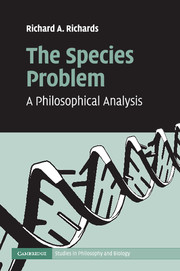Book contents
- Frontmatter
- Contents
- Acknowledgments
- 1 The species problem
- 2 The transformation of Aristotle
- 3 Linnaeus and the naturalists
- 4 Darwin and the proliferation of species concepts
- 5 The division of conceptual labor solution
- 6 Species and the metaphysics of evolution
- 7 Meaning, reference and conceptual change
- 8 Conclusion
- Bibliography
- Index
5 - The division of conceptual labor solution
Published online by Cambridge University Press: 04 April 2011
- Frontmatter
- Contents
- Acknowledgments
- 1 The species problem
- 2 The transformation of Aristotle
- 3 Linnaeus and the naturalists
- 4 Darwin and the proliferation of species concepts
- 5 The division of conceptual labor solution
- 6 Species and the metaphysics of evolution
- 7 Meaning, reference and conceptual change
- 8 Conclusion
- Bibliography
- Index
Summary
SKEPTICAL SOLUTIONS TO THE SPECIES PROBLEM
The three preceding chapters have traced the history of the species problem, revealing both the long endurance of the species problem and the inadequacy of the Essentialism Story. There have been multiple ways of conceiving species, from the enmattered forms and logical universals of Aristotle to the morphological, genealogical, reproductive and geographic conceptions of modern systematists that divide up biodiversity in different ways. The thinking about species that preceded Darwin was clearly not dominated by the property essentialism of this story. But what is also striking in this history are the post-Darwinian advances in our empirical understanding of the living world. We know much more now about the processes governing speciation, development, heredity and biogeography than in Darwin's day. But instead of solving the species problem, it seems to have made it worse – in the proliferation of new species concepts. What we now know about the molecular basis of heredity, for instance, has prompted the formulation of additional species concepts based on various kinds of genetic similarity.
How should we respond to all this? We might conclude that the species problem is not ultimately an empirical problem; it is not due to a lack of knowledge about biodiversity. This will be one of the conclusions of this chapter. Instead the species problem is found in the conceptual framework in which species concepts function. And as we shall also see, the solution to the species problem is likewise found in the conceptual framework.
- Type
- Chapter
- Information
- The Species ProblemA Philosophical Analysis, pp. 113 - 144Publisher: Cambridge University PressPrint publication year: 2010



